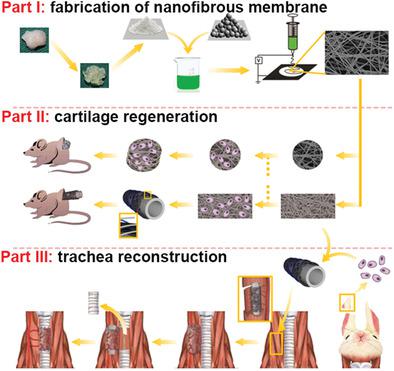当前位置:
X-MOL 学术
›
Adv. Funct. Mater.
›
论文详情
Our official English website, www.x-mol.net, welcomes your feedback! (Note: you will need to create a separate account there.)
Nanofibrillar Decellularized Wharton's Jelly Matrix for Segmental Tracheal Repair
Advanced Functional Materials ( IF 19.0 ) Pub Date : 2020-02-19 , DOI: 10.1002/adfm.201910067 Yong Xu 1 , Liang Duan 1 , Yaqiang Li 2 , Yunlang She 1 , Junjie Zhu 1 , Guangdong Zhou 2 , Gening Jiang 1 , Yang Yang 1
Advanced Functional Materials ( IF 19.0 ) Pub Date : 2020-02-19 , DOI: 10.1002/adfm.201910067 Yong Xu 1 , Liang Duan 1 , Yaqiang Li 2 , Yunlang She 1 , Junjie Zhu 1 , Guangdong Zhou 2 , Gening Jiang 1 , Yang Yang 1
Affiliation

|
Wharton's jelly (WJ) is considered a potential scaffold in tissue‐engineered trachea for its similar composition and function to cartilage tissue. However, the feasibility of using WJ to construct engineered neocartilage tissue has not been reported, let alone tubular tracheal cartilage regeneration and segmental tracheal lesion repair. Here, electrospun nanofibrous membranes composed of three different decellularized WJ matrix (DWJM)/poly(ε‐caprolactone) (PCL) ratios (8:2, 5:5, and 2:8) are fabricated. The results demonstrate improved degradation speed, absorption, and cell adhesion capacity but weakened mechanical properties with increased DWJM content, but satisfactory homogeneous cartilage regeneration is only achieved in the DWJM/PCL (8:2) group after 12 weeks in vivo culture. Furthermore, homogeneous, 3D, tubular, trachea‐shaped cartilage is constructed with a controllable lumen diameter and wall thickness based on the 2D nanofibrous membrane using a modified sandwich model, in which the chondrocyte‐membrane construct is rolled around a silicon tube. Most importantly, by combining the above schemes with previously established vascularization and epithelialization techniques, chondrification, vascularization, and epithelialization are achieved simultaneously thus realizing long‐term (6 months) circumferential tracheal lesion repair in a rabbit model with a biological structure and function similar to that of native trachea, representing a promising approach for the clinical application of tracheal tissue engineering.
中文翻译:

纳米原纤维脱细胞的沃顿胶冻基质,用于节段气管修复
沃顿氏胶冻(WJ)被认为是组织工程气管中的潜在支架,因为其组成和功能与软骨组织相似。然而,尚未报道使用WJ构建工程化的新软骨组织的可行性,更不用说管形气管软骨再生和节段性气管病变修复了。在这里,制造了由三种不同的脱细胞WJ基质(DWJM)/聚(ε-己内酯)(PCL)比(8:2、5:5和2:8)组成的静电纺丝纳米纤维膜。结果表明,随着DWJM含量的增加,降解速度,吸收和细胞粘附能力提高,但机械性能减弱,但是仅在DWJM / PCL(8:2)组体内培养12周后才能实现令人满意的均匀软骨再生。此外,均匀的3D管状 气管形软骨是基于二维纳米纤维膜,使用改进的三明治模型构造的,具有可控的管腔直径和壁厚,其中软骨细胞膜结构围绕硅管滚动。最重要的是,通过将上述方案与先前建立的血管化和上皮化技术相结合,可以同时实现软骨化,血管化和上皮化,从而在生物学结构和功能相似的兔子模型中实现了长期(6个月)圆周型气管病变修复。天然气管,代表了气管组织工程临床应用的一种有前途的方法。软骨细胞膜结构围绕硅管滚动。最重要的是,通过将上述方案与先前建立的血管化和上皮化技术相结合,可以同时实现软骨化,血管化和上皮化,从而在生物学结构和功能相似的兔子模型中实现了长期(6个月)圆周型气管病变修复。天然气管,代表了气管组织工程临床应用的一种有前途的方法。软骨细胞膜结构围绕硅管滚动。最重要的是,通过将上述方案与先前建立的血管化和上皮化技术相结合,可以同时实现软骨化,血管化和上皮化,从而在生物学结构和功能相似的兔子模型中实现了长期(6个月)圆周型气管病变修复。天然气管,代表了气管组织工程临床应用的一种有前途的方法。
更新日期:2020-04-06
中文翻译:

纳米原纤维脱细胞的沃顿胶冻基质,用于节段气管修复
沃顿氏胶冻(WJ)被认为是组织工程气管中的潜在支架,因为其组成和功能与软骨组织相似。然而,尚未报道使用WJ构建工程化的新软骨组织的可行性,更不用说管形气管软骨再生和节段性气管病变修复了。在这里,制造了由三种不同的脱细胞WJ基质(DWJM)/聚(ε-己内酯)(PCL)比(8:2、5:5和2:8)组成的静电纺丝纳米纤维膜。结果表明,随着DWJM含量的增加,降解速度,吸收和细胞粘附能力提高,但机械性能减弱,但是仅在DWJM / PCL(8:2)组体内培养12周后才能实现令人满意的均匀软骨再生。此外,均匀的3D管状 气管形软骨是基于二维纳米纤维膜,使用改进的三明治模型构造的,具有可控的管腔直径和壁厚,其中软骨细胞膜结构围绕硅管滚动。最重要的是,通过将上述方案与先前建立的血管化和上皮化技术相结合,可以同时实现软骨化,血管化和上皮化,从而在生物学结构和功能相似的兔子模型中实现了长期(6个月)圆周型气管病变修复。天然气管,代表了气管组织工程临床应用的一种有前途的方法。软骨细胞膜结构围绕硅管滚动。最重要的是,通过将上述方案与先前建立的血管化和上皮化技术相结合,可以同时实现软骨化,血管化和上皮化,从而在生物学结构和功能相似的兔子模型中实现了长期(6个月)圆周型气管病变修复。天然气管,代表了气管组织工程临床应用的一种有前途的方法。软骨细胞膜结构围绕硅管滚动。最重要的是,通过将上述方案与先前建立的血管化和上皮化技术相结合,可以同时实现软骨化,血管化和上皮化,从而在生物学结构和功能相似的兔子模型中实现了长期(6个月)圆周型气管病变修复。天然气管,代表了气管组织工程临床应用的一种有前途的方法。


























 京公网安备 11010802027423号
京公网安备 11010802027423号